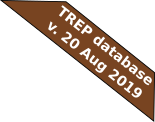

TREP, the TRansposable Elements Platform
TREP data submission
If you would like to submit TE DNA sequences you have compiled during your work, please contact us.
We appreciate a short description of your TE sequences as well as the information which species the sequences are derived from. Also, if available, please include the GenBank accession number. To make our work easier, please try to follow the guidelines below.
Guidelines for submissions
-
Try to determine exactly how big your element is. Cut off flanking sequences because they might contain further repetitive elements which could cause confusion later.
-
Classify the element as precisely as possible following the TE naming system described below. If you are not sure about the classification just write "putative this-or-that".
-
Include the target site duplication (TSD), if possible, when you submit a complete element (as additional proof that you have indeed isolated the complete element).
-
If your element has coding capacity, pay attention that you have it in the right orientation.
-
If your element is especially interesting or very abundant, please let us know.
-
Sequences are preferred in FASTA format. You can send them us separately.
-
If several elements with annotations (e.g. LTR positions) are submitted, the annotations should be submitted separately in table form (e.g. excel spread sheet) similar to the following example:
Name 5'LTR 3'LTR CDS Comment Angela_111A01-1 1-1800 7000-8500 2000-6000 complete Barbara_111A01-1 1-2000 - 2500-5000 3'truncated
TE sequence naming system
TE sequences are named in the following way (items are separated by underscores):
-
3-letter code for superfamily classification (see Wicker et al., 2007)
4-letter species code (see Species list)
TE family name
-
Name of the source sequence the TE was found on. If the exact name is not known or irrelevant, the source might be replaced by 'RND' (stands for random)
Example: RLC_Tmon_Angela_109N23-1
RLC: Superfamily Copia
Tmon: T. monococcum
Angela: TE family name
109N23-1: copy number one on BAC 109N23